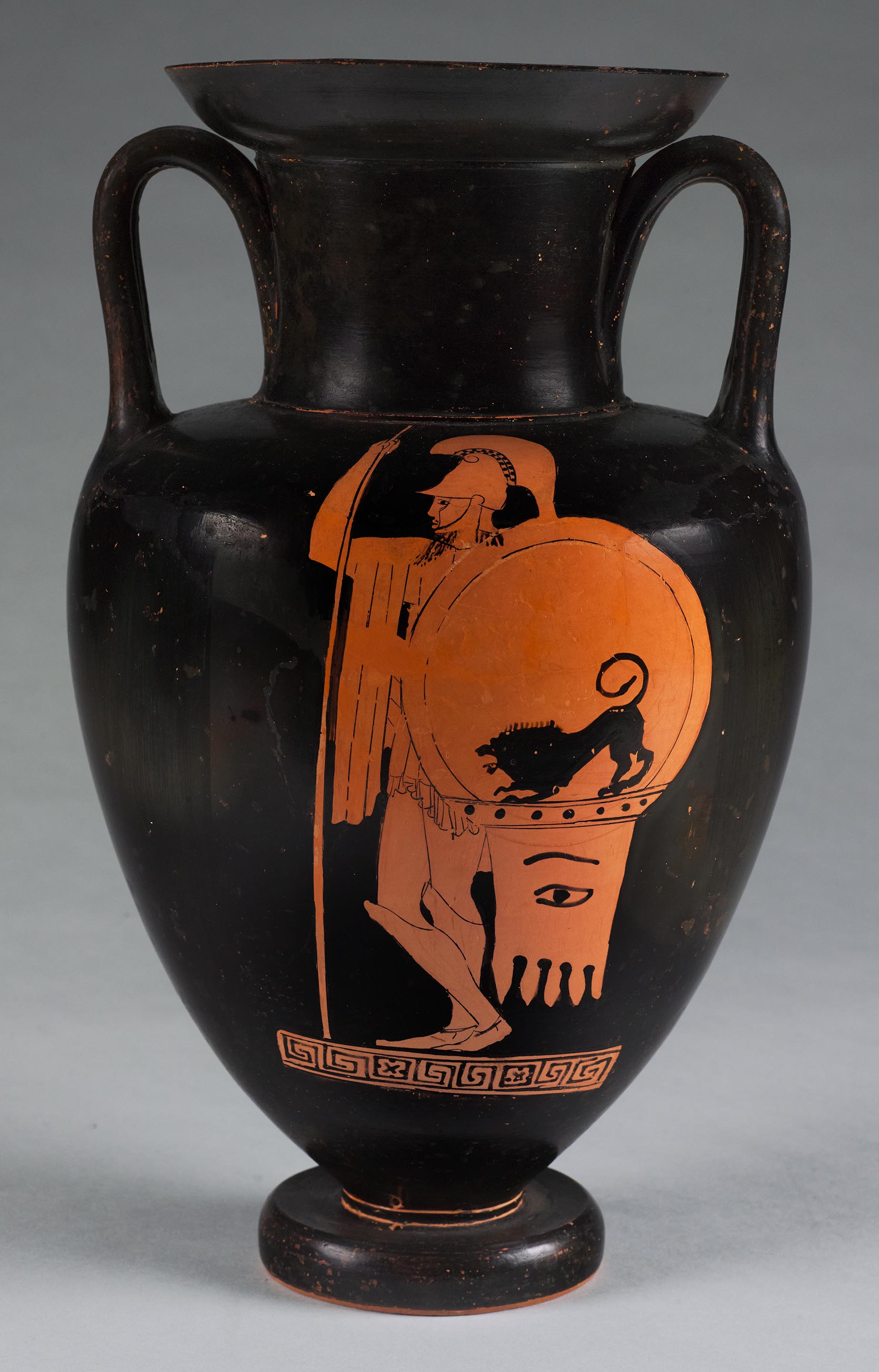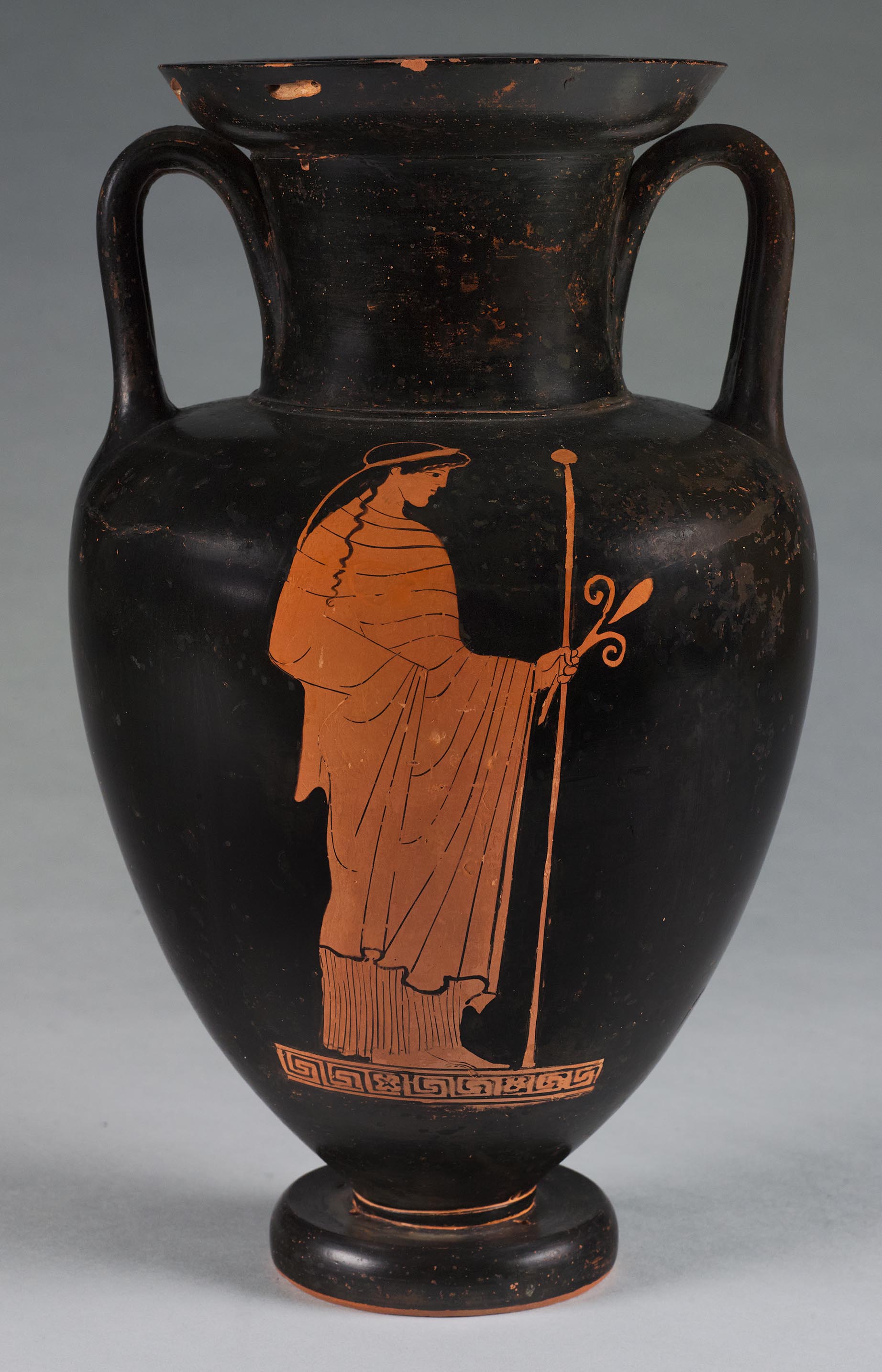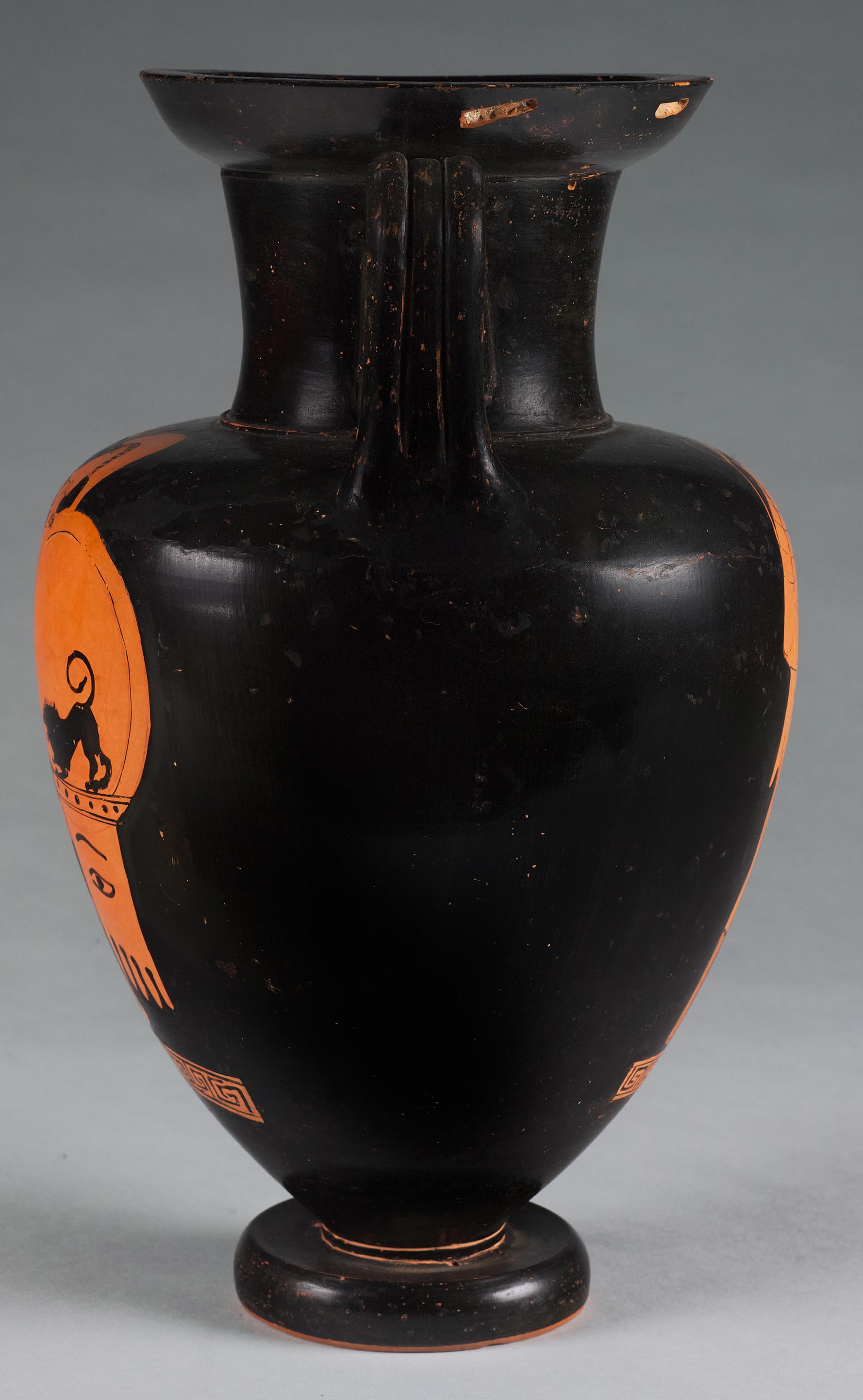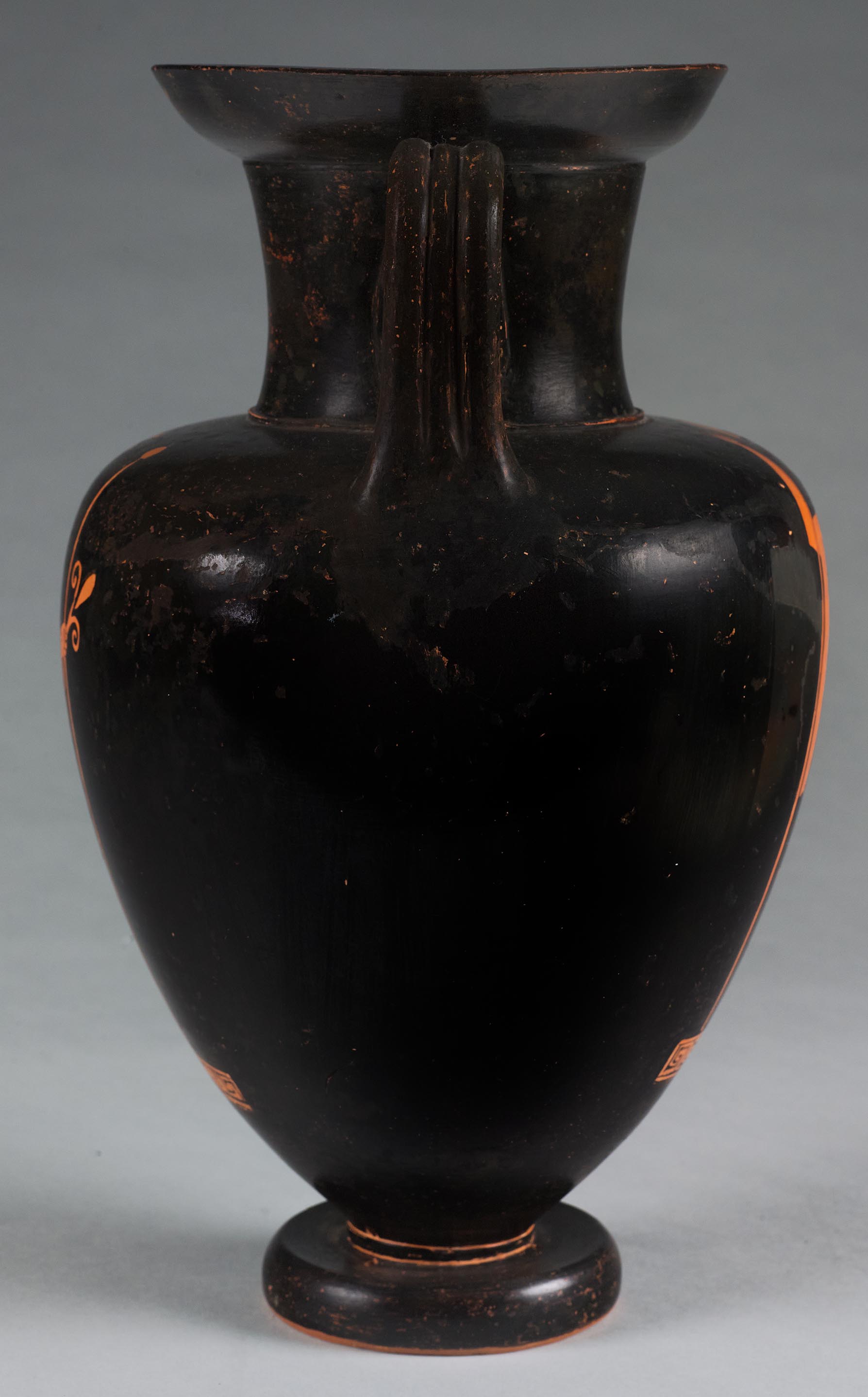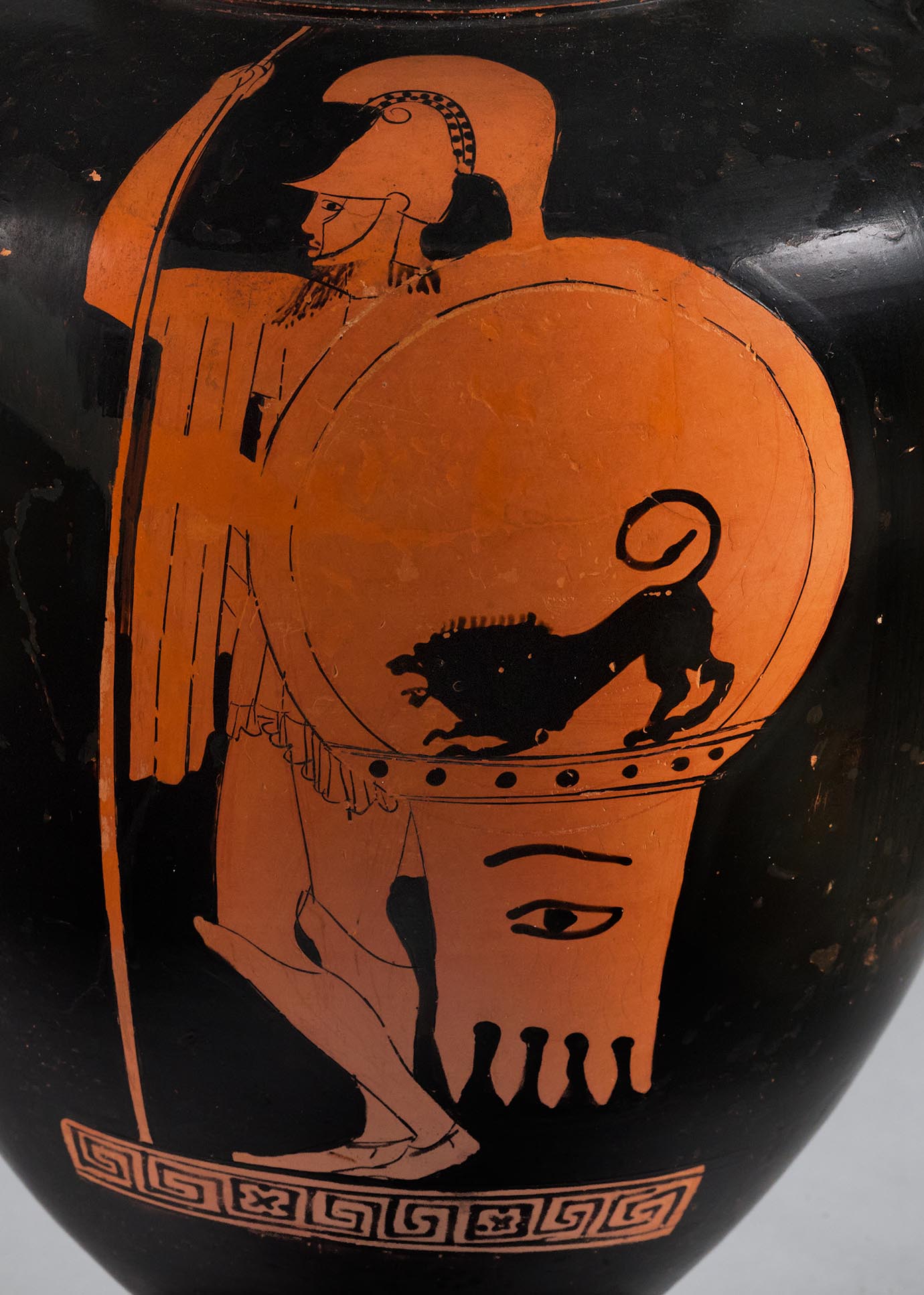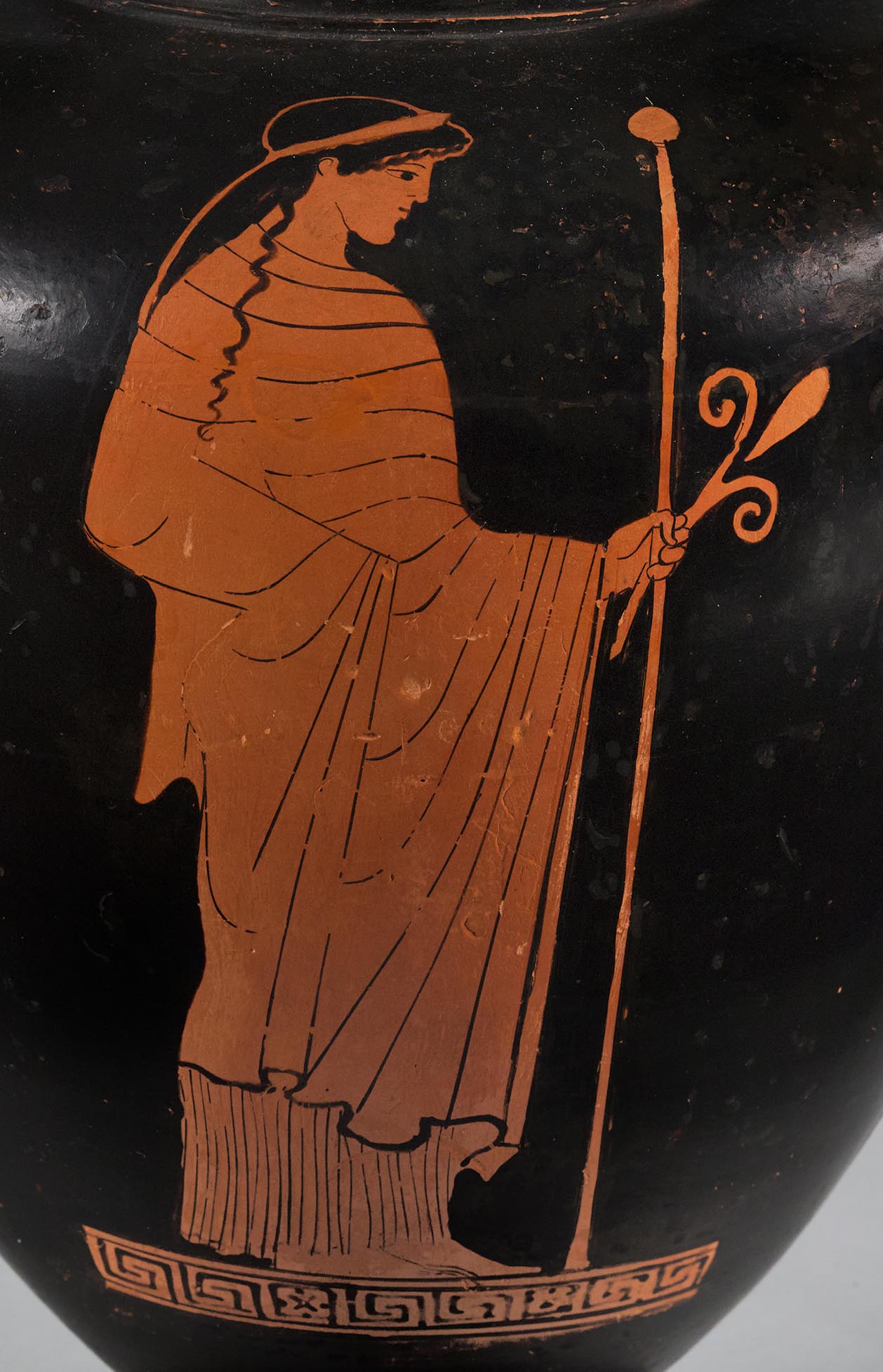Provenance
1983, Sotheby’s (London); 1985, Sotheby’s (London); 1985–91, Marc Sanders (Princeton, NJ); 1991, gift, Marc Sanders to Princeton University.
Shape and Ornament
Echinus mouth with deeply concave interior, flat on top, black. Short, slightly concave neck, interior black; thin ridge at the base of neck. Triple-reeded handles, black. Below figures on both sides, segment of pairs of stopt meanders alternating with saltire squares. Disk foot separated from body by narrow fillet; top and side of foot black, except for bottom edge of the side; resting surface and underside reserved. Upper surface of foot slightly concave.
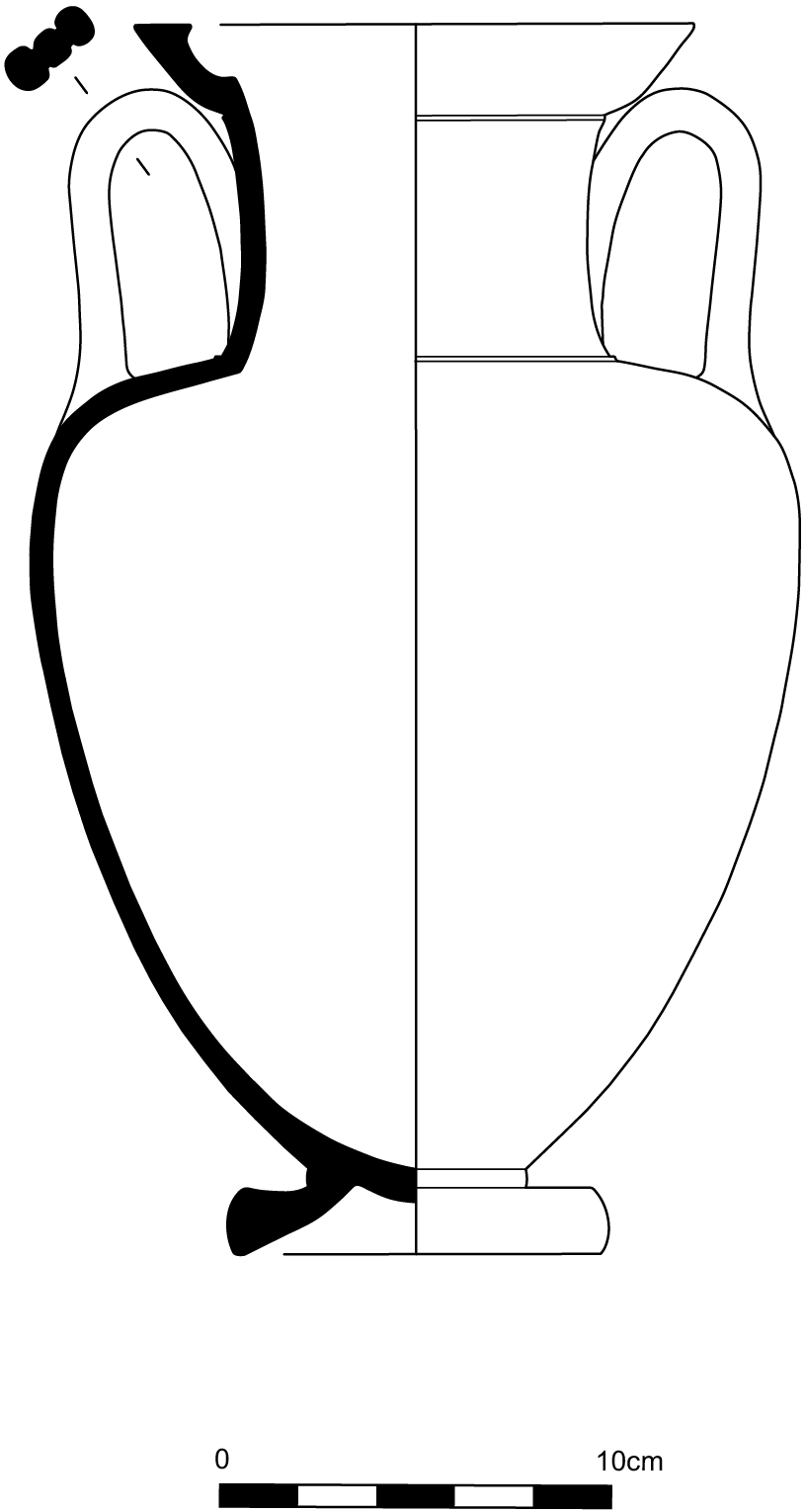
Subject
A. Warrior. The bearded warrior stands in profile to the left in a relaxed pose, with his right leg crossed over his left, and with part of his weight supported by a spear that he holds vertically in his right hand. His right arm is flexed and raised to grasp the upper part of the spear. The spear shaft extends to the neck of the amphora, with the blade not depicted. He wears a Thracian helmet with a low crest and dotted crest holder, cuirass, chitoniskos, a cloak draped over his right arm and around his back, and greaves. On his left arm he holds a shield that covers much of his torso. The shield device is a male lion, executed in black silhouette, which occupies the lower half of the shield. The lion stands on the line of a fringed apron decorated with a profile human eye and brow.
B. Woman. The woman stands in profile to the right, wearing a chiton and himation. The outlines of her flexed right arm at her side and hip are visible beneath her garments. Her left arm is flexed and held at her side. In her left hand she holds a flower with two volutes and a central frond, and a tall scepter with a spherical knob, which suggests that she may be a goddess or mortal queen. A fillet or diadem binds her long hair, which hangs down her back. A single twisting tress extends over her right shoulder. Since she faces the warrior on the opposite side, the two figures should likely be connected to form a scene of a warrior’s departure.
Attribution and Date
Attributed to the Tithonos Painter [J. R. Guy]. Circa 470–460 BCE.
Dimensions and Condition
h. 31.2 cm; w. 19.6 cm; diam. of mouth 14.4 cm; diam. of foot 9.5 cm. Broken and mended, with small pieces restored in plaster. Several details of the figural drawing repainted, including in the area of the warrior’s right upper arm, beard, cheekpiece, and upper shield. Small areas of black gloss repainted, primarily around handle BA. Other restored areas, such as sections of the warrior’s cloak and shield, repainted only to match the color of the reserved clay. Some relief lines on the woman have worn off, such as on her buttocks. Black gloss on either side of the warrior misfired milky gray. Drill holes from an ancient repair visible on the underside of the foot.
Technical Features
Preliminary sketch. Those on the shield and apron suggest that the entire apparatus was originally drawn higher up. Relief contour for the warrior except for the right elbow, the left side of the shield apron, and the front of the helmet crest. Relief contour on side B only for the scepter, the lower portion of the woman’s chin, her right elbow, and the line of the himation below her left hand. Shield rim incised with a compass.
Inscriptions
Incised graffito under foot:
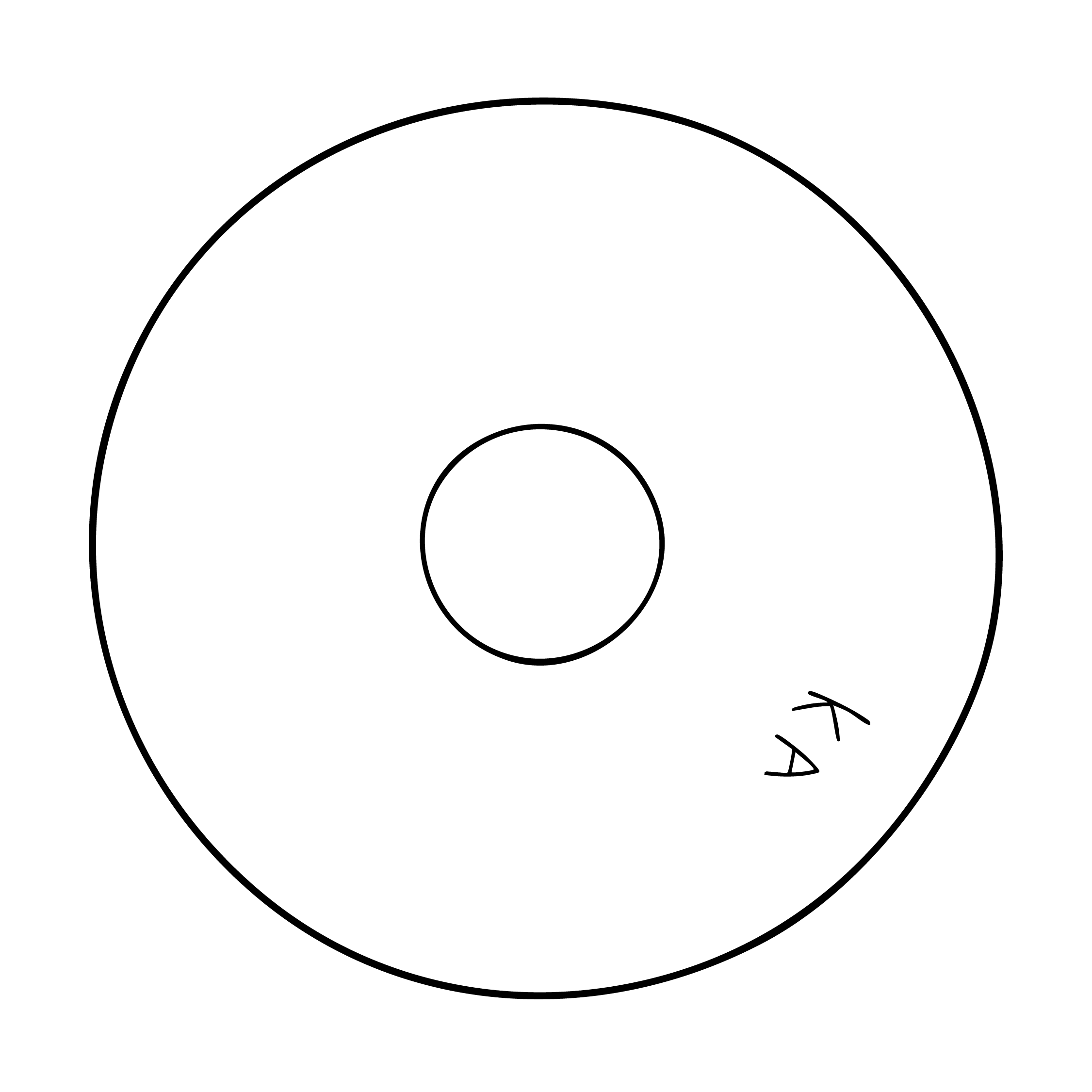
Bibliography
Sotheby’s, Antiquities, auc. cat., July 11–12, 1983, London, lot 346; Sotheby’s, Antiquities, auc. cat., July 17–18, 1985, London, lot 290 [not illus.]; Abbreviation: BAPDBeazley Archive Pottery Database. http://www.beazley.ox.ac.uk 9045.
Comparanda
For the Tithonos Painter, see Abbreviation: ARV2J. D. Beazley. Attic Red-Figure Vase-Painters. 2nd ed. Oxford, 1963 309–10, 1644; Abbreviation: ParalipomenaJ. D. Beazley. Paralipomena: Additions to Attic Black-Figure Vase-Painters and to Attic Red-Figure Vase-Painters. Oxford, 1971 357; Abbreviation: BAdd2Carpenter, T. H., ed. 1989. Beazley Addenda: Additional References to ABV, ARV2, and Paralipomena. 2nd ed. Oxford: Published for the British Academy by Oxford University Press. 213; Abbreviation: Robertson, Art of Vase-PaintingM. Robertson, The Art of Vase-Painting in Classical Athens. Cambridge, 1992, 129–30; J. H. Oakley, “Associates and Followers of the Berlin Painter,” in Abbreviation: Padgett, Berlin PainterJ. M. Padgett, with contributions by N. T. Arrington et al. The Berlin Painter and His World: Athenian Vase-Painting in the Early Fifth Century B.C. Princeton, 2017, 67–68; id., “Red-Figure Nolan Amphora,” in Abbreviation: Padgett, Berlin PainterJ. M. Padgett, with contributions by N. T. Arrington et al. The Berlin Painter and His World: Athenian Vase-Painting in the Early Fifth Century B.C. Princeton, 2017, 289. The Tithonos Painter, a follower of the Berlin Painter, primarily painted Nolan amphorae and lekythoi, depicting a single figure on each side in the manner popularized by the master. Beazley described him as “the same kind of person as the Dutuit Painter, but less spruce, a little heavier-handed . . . [he] may be said to face toward the Berlin Painter” (Abbreviation: Beazley, Vases in American MuseumsJ. D. Beazley. Attic Red-Figured Vases in American Museums. Cambridge, Mass., 1918, 69). In the painter’s oeuvre, the closest parallel to this vase is a Nolan amphora formerly in the Zimmermann Collection, Bremen, and recently in the art market (Christie’s, NY, Ancient Greek Vases from the Zimmermann Collection, auc. cat., April 9, 2024, lot 29; M. Steinhart, Das Motiv des Auges in der griechischen Bildkunst [Mainz, 1995], 113, no. 1007, pl. 45; id., Töpferkunst und Meisterzeichnung: Attische Wein- und Ölgefäße aus der Sammlung Zimmermann [Mainz, 1996], 110–13, no. 24; Abbreviation: BAPDBeazley Archive Pottery Database. http://www.beazley.ox.ac.uk 46963). In his earlier publication, Steinhart compared the Bremen vase to the Nolan that later would come to Princeton, but did not attribute the latter to the Tithonos Painter, whose work it surely is. The treatment of the young warrior’s shield—lion, apron, eye—is identical to that on the Princeton amphora, and the woman libating on the reverse is also cut from the same cloth. A departing warrior on a Nolan by the Berlin Painter also combines a lion device with a shield apron: Naples H 3137 (Abbreviation: ARV2J. D. Beazley. Attic Red-Figure Vase-Painters. 2nd ed. Oxford, 1963 201.62; Abbreviation: BAPDBeazley Archive Pottery Database. http://www.beazley.ox.ac.uk 201870). The pairing occurs again—now, once more, with eyes on the apron—on a stamnos by the Brygos Painter (Athens 5898: O. E. Tzachou-Alexandri, “Le stamnos d’Athènes no 5898 du peintre de Brygos,” Abbreviation: BCHBulletin de correspondance hellénique 125 [2001]: 89–108), and on a column-krater attributed by Padgett to the Leningrad Painter (Sotheby’s, Antiquities and Islamic Art, auc. cat., June 4, 1998, New York, NY, lot 129; Abbreviation: BAPDBeazley Archive Pottery Database. http://www.beazley.ox.ac.uk 29351). For the woman’s enveloping himation, which reveals her arm and buttock beneath, cf., by the Tithonos Painter, the woman on the reverse of Paris, Louvre G 205 (Abbreviation: ARV2J. D. Beazley. Attic Red-Figure Vase-Painters. 2nd ed. Oxford, 1963 309.2; Abbreviation: BAPDBeazley Archive Pottery Database. http://www.beazley.ox.ac.uk 203172). For the folds of her himation and the thickened black hemline, cf. Aberdeen 64032 (Abbreviation: ARV2J. D. Beazley. Attic Red-Figure Vase-Painters. 2nd ed. Oxford, 1963 309.11; Abbreviation: BAPDBeazley Archive Pottery Database. http://www.beazley.ox.ac.uk 203181).
For neck amphorae, including Nolans, by the Berlin Painter and his followers, see comparanda for Princeton 2018-132 (Entry 2). The rather squat appearance of this example, including its short neck, is typical of the early Nolans from the Berlin Painter’s workshop: cf. Naples H 3087 (Abbreviation: ARV2J. D. Beazley. Attic Red-Figure Vase-Painters. 2nd ed. Oxford, 1963 201.68; Abbreviation: BAPDBeazley Archive Pottery Database. http://www.beazley.ox.ac.uk 201876).
The figures on both sides of the vase apparently form a scene of departure. This may be compared with another Nolan by the Tithonos Painter that shows Nestor holding a scepter on one side bidding farewell to a warrior, perhaps his son Antilochus, on the other side: Paris, Louvre G 213 (Abbreviation: ARV2J. D. Beazley. Attic Red-Figure Vase-Painters. 2nd ed. Oxford, 1963 309.4; Abbreviation: BAPDBeazley Archive Pottery Database. http://www.beazley.ox.ac.uk 203174). If the woman on Princeton’s amphora is a goddess, her scepter indicates that she could be the queen of the gods, Hera. However, as there seems nothing divine about the warrior, it is more likely that the subject takes place in the realm of mortals. Women in mortal departure scenes rarely hold scepters and more often bear the implements of libations, such as oinochoai or phialai: cf. Naples H 3137 (supra); and a neck amphora attributed to the Cleveland Painter, Paris, Louvre G 200 (Abbreviation: ARV2J. D. Beazley. Attic Red-Figure Vase-Painters. 2nd ed. Oxford, 1963 517.10; Abbreviation: BAPDBeazley Archive Pottery Database. http://www.beazley.ox.ac.uk 205798). The scepter on the Princeton amphora could indicate royalty, thus transforming the scene into a warrior-king taking leave of his mortal queen. Women who grasp scepters in scenes of departure often, however, remain anonymous to modern viewers without the help of inscriptions: cf., inter alia, Copenhagen 2698 (Abbreviation: ARV2J. D. Beazley. Attic Red-Figure Vase-Painters. 2nd ed. Oxford, 1963 616.8; Abbreviation: BAPDBeazley Archive Pottery Database. http://www.beazley.ox.ac.uk 207128).
For the graffito, see Johnston’s type 11F, in which the kappa and alpha can either be in ligature or, as here, separate (Abbreviation: Johnston, TrademarksJohnston, A. W. 1979. Trademarks on Greek Vases. Warminster: Aris and Philips., 159–60). Johnston concludes that the KA is most likely not a vase-name abbreviation but could instead refer to a personal name.
